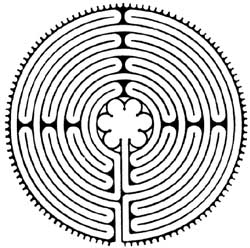
JERUSALEM
THE CITY ABOVE, THE MOTHER OF US ALL
"As the navel is set in the centre of the human body,
so is the land of Israel the navel of the world...
situated in the centre of the world,
and Jerusalem in the centre of the land of Israel,
and the sanctuary in the centre of Jerusalem,
and the holy place in the centre of the sanctuary,
and the ark in the centre of the holy place,
and the foundation stone before the holy place,
because from it the world was founded."
Midrash Tanchuma, Qedoshim.
THE GENESIS AND GEOMETRY OF THE LABYRINTH,
ARCHITECTURE, HIDDEN LANGUAGE, MYTHS, AND RITUALS
by Patrick Conty

THE ENIGMA
The story of how Ariadne fell in love with the brave and daring Theseus is well known. Betraying her father, King Minos, and her half-brother, the Minotaur, Ariadne gave Theseus a ball of thread that unwound before him, showing him the way through THE LABYRINTH built by Daedalus to imprison the Minotaur. (Half man, half Taurus). Thus equipped, Theseus escaped from the inextricable labyrinth, and after having killed the Minotaur and liberated his companions, he set sail for Athens with Ariadne, whom, for reasons that remain obscure, he abandoned along the way on the island of Naxos.
The myth presents us, as it did Theseus, with a specific problem: HOW TO FIND THE PATH FROM THE ENTRANCE TO THE CENTER OF THE MAZE. Theseus certainly did not just let the thread unroll behind him as he advanced...Rather he used the thread to find the center. The task is linked to a geometric and topological problem epitomized by the GORDIAN KNOT , which had to be unraveled without one's knowing the location of the ends of the rope.
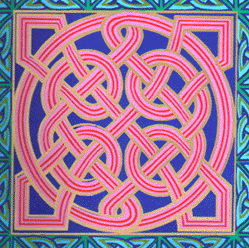
Gordius, legendary king of Phyrigia, used this knot to attach a yoke TO THE SHAFT OF HIS CHARIOT. It was later preserved in Zeus's temple at Gordium. THE LEGEND HELD THAT WHOEVER COULD UNTIE THE KNOT WOULD BECOME MASTER OF THE WORLD. Alexander the Great, FAR TOO IMPATIENT FOR THIS ENDEAVOR, cut it in half with his sword.
If the rope of the Gordian knot were untied (figured out) and rolled into a ball to avoid its getting tangled, would it not be similar to Ariadne's ball of thread? It could then be seen as representing the complex path of the rope in the knot, at once untangled and arranged in a new manner, BUT AS IF PRESERVED IN MEMORY. The image of the ball of thread that indicates the way as it unwinds can also be seen as a backward projection of a film capturing the movement of the knot being unraveled and of the rope being progressively rolled into a ball. Ariadne's thread seems to be a subtle link between two similar topological problems.
Even though the quest for a solution should be less burdensome for us than it was for Theseus, SEEING THAT WE NO LONGER HAVE TO FEAR A CONFRONTATION WITH THE MINOTAUR (?...continued)...
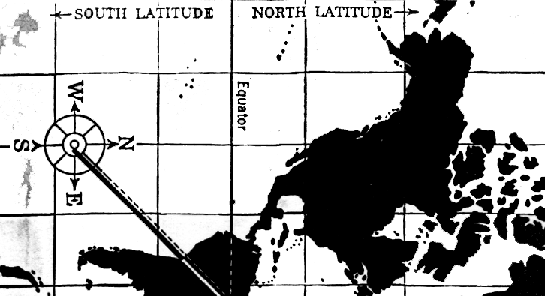
There is, however, the Behemoth (Job 40:15-24, KJV). The author, Patrick Conty, lives in the south of France, and therefore might appreciate ( in his own quietly spiritual and intellectual way) the connection that exists between his statement about the Minotaur and the actual conflict that is being waged in the earth at this present time, not only between the majority of the French people (as well as others all throughout the earth) and the American government over the issue of War in the Middle East, but between the millions who are rising up inside America, against the great Beast, over the issue of WAR itself. But more than this, the conflict shall soon revert to the question, or rather the meaning, of history, and then to the very meaning of LIFE itself and our connection to all that is Divine in the world.
We have included the entire first chapter of Patrick Conty's deeply insightful, inquisitive and timely work here, for the very simple reason that it is "timely." It brings all of us to the very threshold of our present human dilemma. It places the human quest in its proper historical and spiritual perspective, and poses on behalf of all of us all of the necessary questions. The author has heard the voice of the Spirit Herself saying "Ask, seek, knock," so that She Herself can provide the answers. Without the proper questions the Universe finds no means to provide the answers. The mystery of the Labyrinth? It is indeed the way to Jerusalem. It is the way to Eternal Life itself.
(continued)...the problem seems nonetheless impossible to solve, since no one agrees about what the labyrinth really was or where it was located. Some suggest that it was the palace of Knossos itself, BUILT AS A REPLICA OF THE FAMOUS EGYPTIAN LABYRINTH that disappeared without a trace.
Others state that it refers to neighboring quarries, or to those of Crotone, in Calabria. Still others suggest that the myth corresponds to a ritual that is represented in one of the frescoes in the palace of Knossis that represents a bullfighting game. According to Herbinger, this fresco can be interpreted as a ritual calendar in which the circles in the border represent the Lunar months...
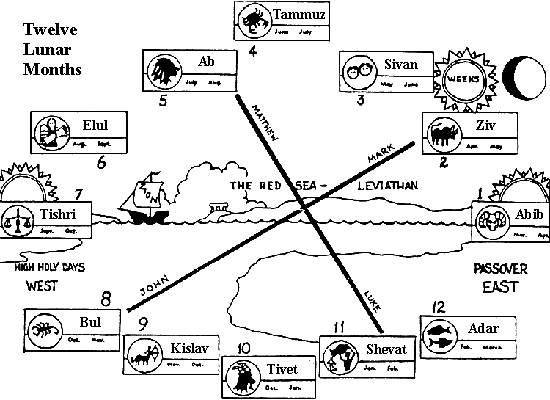
...There are a multitude of mazes, labyrinths, and drawings depicting them from all over the world, BUT THEIR SOLUTIONS ARE TOO OBVIOUS OR TOO SIMPLE TO ENTIRELY JUSTIFY THE INESCAPABLE CHARACTER OF THE LABYRINTH REFERRED TO IN THE MYTH...
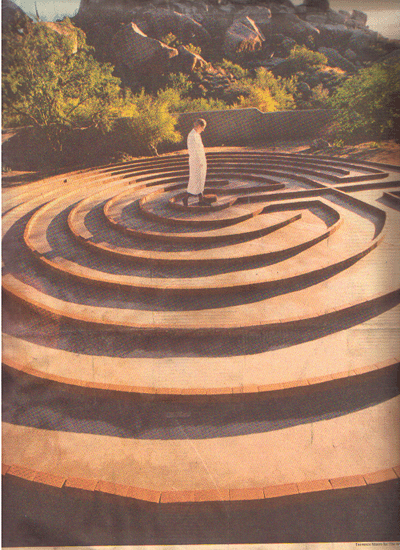
A Journey to the Center, to Tiphereth.
Any sinuous path, any fortress or fortified enclosure, can eventually represent or evoke a labyrinth. When its angles are rounded, the (path) can also take on the form of A SERIES OF WAVES THAT REPRESENT THE SEA OR THE ELEMENT OF WATER AND THUS, BY EXTENSION, ALL OF LIFE. Without being able to formulate the problem we are confronted with explicitly, it is difficult, if not impossible, to find a strategy capable of bringing us nearer to a solution.
Could we then see the labyrinth in the same way as Kafka's castle or court? Should we see it as a simple metaphor or as a way of evoking those things that never happened but always are? Does this mean that the myth is speaking to us about Being?
In any case, the myths and legends in which all civilizations since the beginning of history have presented different versions of the labyrinth raise this question: WHAT IS THE MEANING OF THE MYTH? Here again, a precise answer is difficult to formulate, as many myths present different versions, each one offering many different possibilities for interpretation. Like Proteus, the labyrinth eludes all attempts to lay hold of it by constantly presenting itself in new forms. Where the Greek myth presents the labyrinth as a prison from which escape is impossible, the Aeneid suggests THAT IT HIDES THE ENTRANCE TO HADES.
The Mahabharata describes it as a lethal formation used in the Battle of Kurukshetra, but in the Ramayana it is an impregnable fortified castle, lair of the (Ten Headed) demon Ravana. (Revelation 12:3; 13:1). In tantric art the labyrinth is a yantra symbolizing citta, or the mind. The Native Americans see it as the point of emergence and path along which their distant ancestors entered this world. In certain parts of Africa the labyrinth takes the form of a strategic duel. FOR MEDIEVAL MAN IT IS THE ROAD TO JERUSALEM, THE PATH THAT LED THE PILGRIM TO A TOTAL REORIENTATION. But it can also represent the the siege and storming of Troy, and for the Jews it represented the capture of Jericho. In each case, the meaning given to the labyrinth is different (but not really), which makes for great flexibility in its interpretation. THIS VARIETY CAN INDICATE THAT THE LABYRINTH'S ORIGINAL OR FUNDAMENTAL SIGNIFICANCE IS EITHER LOST OR VERY BROAD. Thus the ancient Egyptian labyrinth located near Lake Moeris was known to be A SORT OF MATRIX, reflecting the structure of the universe...
In Korea, there is a labyrinth called the Ocean Seal, conceived by the first patriarch of Hua-yen Buddhism to contain a fundamental metaphysical text, called THE ROUND OR ALL-EMBRACING VIEW, and whose profound meaning it seems to reflect. Finally, the very ancient Tihuanaco calendar, like the one at Knossos...seems to link the structure of the labyrinth TO THE PASSAGE OF TIME....Kerenyi concludes by saying that the labyrinth must remain a mystery, which seems more than a bit evasive! If we can legitimately suppose that the labyrinth is connected to ancient mysteries, it remains to be seen how this is so, AND TO WHICH MYSTERIES?.
In fact interpretations of the labyrinth do exist. (continued)...
Jill Purce, in her work entitled The Mystic Spiral, says:
"The earliest known labyrinth is that dating from the 19th century B.C. in Egypt; the most famous was in Minoan Crete. These, and some of the earliest spiral rock engravings from Paleolithic times, are reminders of man's increasing preoccupation with the spiral order and his own spiral development.
As the labyrinth creates and dissolves, expands and contracts, so it reveals and conceals, It is cosmos to those who know the way, and chaos to those who lose it. It is Ariadne's thread, whose windings create the world and yet enables us to unravel it...
I give unto you the end of the Golden String,
Only wind it in a ball,
It will lead you in at Heaven's Gate
Built in Jerusalem's Wall. William Blake, Jerusalem.
The point or centre, in those labyrinths depicted in the pavement floors of many medieval cathedrals, is sometimes a depiction of Theseus and the Minotaur. The symbolism is that of the original Cretan--an initiatory hero test, the overcoming of death at the center, and a subsequent return or rebirth into life. For, as it is necessary to be born from the womb to see this world, only he who is born from himself sees the other world. "He who is not twice born will not ascend to the Kingdom of Heaven." Other cathedral labyrinths depict the architect at the center, sometimes symbolized in the person of Daedalus, the builder of the Cretan maze. Since treading the maze was a pilgrimage to Jerusalem in miniature, Daedalus also represents the Divine Architect. The Mystic Spiral, p.29.
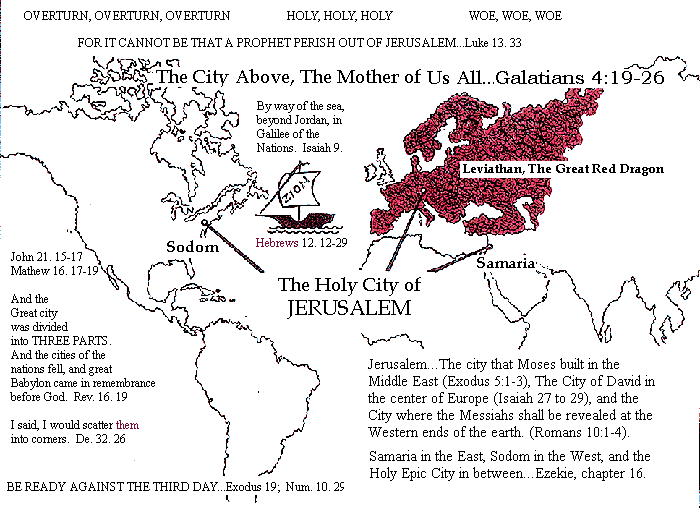
(Patrick Conty continued)...but as we shall see, they do not solve the problem mentioned Kerenyi. WESTERN TRADITION GENERALLY REPRESENTS THE LABYRINTH AS A WORLD THAT HOLDS US CAPTIVE, WITH ARIADNE'S THREAD BEING THE SYMBOL OF LIBERATION. If this liberation is that promised by all religions, the key to attaining it is found precisely in the ancient mysteries. The image of the labyrinth seems to echo the question--"Where are you?"--that God asked Adam after he had committed the transgression that excluded him for Paradise. Here again, in yet another form, we are faced WITH A COMPLEX TOPOLOGICAL SITUATION (topos in Greek means "place" or "location"). If the labyrinth is the path of all seeking, it must also hold the answer to the Sphinx's questions: "WHO ARE YOU? WHERE DO YOU COME FROM? WHERE ARE YOU GOING?" Or to the Quo vadis heard by Paul on the road to Damascus. But it can also become the symbol for the center of the primordial castle spoken of by mystics AND KNOWN AS THE HOME OF THE SPIRIT, such as that described by Meister Eckhart: "There is within the soul a fortified castle where even God's eye, in its three manifestations, cannot penetrate because it is the abode of pure unity." This notion of an impregnable castle seems to contradict that of an inescapable prison, BUT WHEN THE PATH LEADING OUT OF THE LABYRINTH APPEARS, IT NEED ONLY BE REVERSED TO BECOME THE PATH LEADING FROM THE EXIT TO THE CENTER. TO FIND THE PATH LEADING TO LIBERATION ONE MUST HAVE ALREADY TRAVELED THE PATH LEADING TO THE CENTER, SYMBOL OF PURE UNITY, FOR IT IS ONLY THIS KNOWLEDGE THAT IS CAPABALE OF BRINGING ABOUT FINAL LIBERATION. In other words: "Everything that appears to be without is in fact within." ...
The traditional Western interpretation applies to medieval labyrinths, THOSE CALLED THE ROAD TO JERUSALEM, which were laid into the floors of churches and basilicas. JERUSALEM HERE DESIGNATES THE CELESTIAL CITY--THAT IS, PARADISE RECOVERED.
If not suspect, the interpretation is at least incomplete. It presents a single meaning for a poly-semous myth that offers a constellation of interwoven meanings. (continued)...
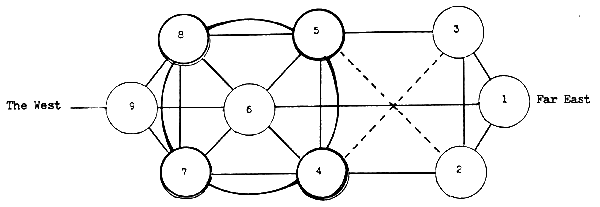
Christianity in the West, Buddhism in the East.
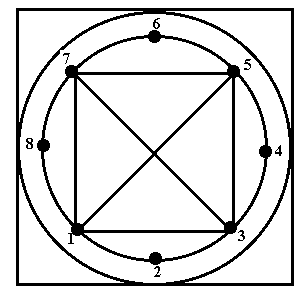
Four Noble Truths and the Eightfold Path
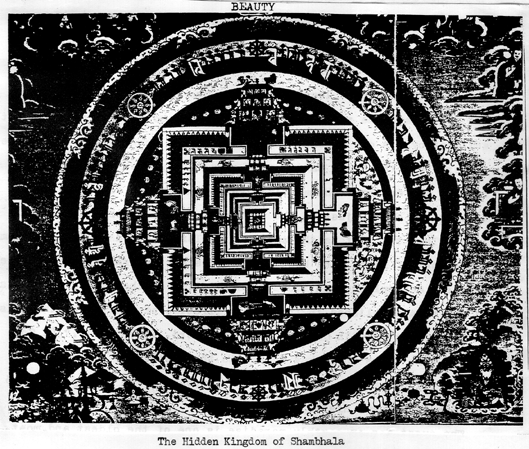
THE HIDDEN KINGDOM OF SHAMBHALA (JERUSALEM)
"The quest for an earthly Paradise is one of the oldest and most enduring themes of mythology. Ancient clay tablets dating back to the 2nd millennium B.C. tell of the hero Gilgamesh and his epic journey to the Garden of the Sun in search of the secrets of immortality. In the 2nd century B.C. the Chinese emperor Wu Ti sent envoys looking for the mythical palace of Hsi Wang Mu--the dwelling place of the immortals, hidden in the mysterious Kunlun Mountains of Central Asia. During the Middle Ages Irish monks set out on the Atlantic, seeking legendary isles of the Blessed where they might find salvation. Centuries later the Pilgrims crossed the ocean, hoping to find a Garden of Eden in the new world.
Tibetans have long held a tradition of just such an earthly Paradise, called Shambhala--a mythical kingdom that is hidden among the Snow mountains north of Tibet. (Snow, a six-stemmed crystal is another symbol of that hidden place named Beauty on the Tree of Life). There in the sanctuary free from strife and want, a line of divine kings is said to be preserving the highest teachings of Buddhism for a time in the future when barbarians will destroy all true religion in the world outside. When the barbarians try to conquer even Shambhala, a Saviour king will emerge with a supernatural army to defeat them in great battle and establish a golden age throughout the world."
A Buddhist prayer: "MAY I QUICKLY TAKE BIRTH IN SHAMBHALA, THE TREASURY OF JEWELS, AND COMPLETE THE STAGES OF THE HIGHEST YOGA TANTRA."
(continued)...In this medieval tradition one of the many implicit meanings of the myth becomes explicit, and thus finds itself separated from its context in order to justify the dogmas and mysteries of the Christian faith. Ariadne's thread becomes simply a symbol of grace or even the string of a rosary. But we shall never understand the importance of the thread or how it is supposed to guide the pilgrim. The concrete topological problem of the myth--how to get out of the maze--fades and becomes unsolvable. The relationship between geometry and metaphysics remains obscure.
The exegetical method used by the Western tradition to interpret the myth is in itself mysterious and obscure, AS IT SPRINGS FROM AN INTIMATE CONTACT WITH A REVELATION THAT TRANSMITS, OR RATHER TRANSLATES OR TRANSPOSES, AN OLD MESSAGE INTO A NEW CONTEXT. This revelation can be achieved from arduous studies, but it can also be the fruit of uncommon experiences, accidents, or a destiny or pathway that more often than not can only be described in singularly subjective terms. This destiny is precisely one of the themes interwoven with that of the labyrinth in Jorge Luis Borge's short stories. We can also find it in one of the inscriptions that accompanies a labyrinth from the Renaissance, FATA VIAM INVENIENT, "All destinies find their path." As it reveals itself, the meaning of the labyrinth is transformed, taking on yet another disguise.
Yet by the very fact that these images handed down from tradition are incomplete and yet explicit, they speak to us more directly than the myth. Sometimes, when we try to think about our life AND TO UNDERSTAND ITS ULTIMATE MEANING, it does effectively seem to stretch before us devoid of all purpose, to follow a somewhat random path across a tangle of other paths, with all of them leading nowhere. And when we try to avoid dead ends, to find an exit or a reason for living, to get to the bottom of it or to establish a more satisfying itinerary, we find only new twists and loops in a Gordian knot; the more we struggle, the more it seems to confine us. IF FINALLY, WE RECOGNIZE THE PAST, LIKE OUR REFLECTION IN A MIRROR, we discover a sort of Minotaur staring back at us, half man, half beast. (Please consider Ecclesiastes 3:16-21). And so, if we tend to drift, to go around in circles, to follow goals that ultimately lead us away from our most essential desire, to which no compass can direct us, we can easily suspect that we are living, like the character in Robert Pirsig's Zen and the Art of Motorcycle Maintenance, an inextricable maze...
It is remarkable that in our age, when the idea of the Fates unwinding the thread of our destiny seems old-fashioned and makes us smile, THE LABYRINTH IS STILL LIKENED TO THE PROBLEM OF THE MEANING OF OUR EXISTENCE and even haunts our consciousness with renewed vigor as a symbol of a quest that has become ever more obscure. The most subtle writers of our time, Kafka, Joyce, Roussel, Borges, Robbe-Grillet, Eco, have all found in the maze an effective image to represent our world, and have each proposed his own version, which he presents as a castle, a court, the city of Dublin, an immense library, a secret garden,or even a strategy. Perhaps this can be attributed to the fact that with the arrival of the scientific revolution, language itself has become a kind of maze:
"The social subject itself seems to dissolve in this dissemination of language games. The social bond is linguistic, but it is not woven with a single thread. It is a fabric formed the intersection of at least two (and in reality an indeterminate number of) language games, obeying different rules. Wittgenstein writes: 'Our language can be seen as an ancient city; a maze of little streets and squares, of old and new houses with additions from recent periods; and this surrounded by a multitude of new boroughs with straight streets and uniform houses.'"
Scientists themselves use these images to describe the inconclusive or indeterminate character of knowledge that modern science leads to. Rudy Rucker gives us an example when he describes Godel's incompleteness theorem: "Mathematicians can never formulate a correct and complete description of the set of ordinary whole numbers (0, 1, 2, 3 . . .). They are thus left like Kafka's K. in the Castle, unable to escape from the imprisoning passageways. Endlessly they hurry up and down corridors, meeting people, knocking on doors, conducting their investigations. But nowhere in the castle of science is there a final exit onto absolute truth.
Even the new scientific method, which seemed to have cleared A STRAIGHT PATH, is now described as a labyrinth:
"It is now less a path than a multitude of tracks, a map: the labyrinthine forest of the intellectual's wanderings...The scientific problem is an interrogation of intersubjectivity...It is enclosed within the complex graph of the encyclopedic labyrinth. So that if the labyrinth itself torments and is problematical, in and of itself and by the complication of its intersections, it is nonetheless both causing the problems and solving them precisely by the very power of its intersections. The object of science grows, correlatively in power, and its problems in generalities. The scientific problem raises itself suddenly to universalizing dignities, recognized of late, by the philosophical questions: less the facing of an obstacle than the confrontation of a community to a global complication that concerns it and that it concerns."
But when we speak about a labyrinth today, are we trying to analyze or chart a structure in order to find an exit or a center, or is it more in order to survive within it and adapt like intelligent laboratory rats? Today, Ariadne's thread is ignored, and it seems that only the negative aspect of the labyrinth has been maintained. AS FOR ITS POSITIVE ASPECTS, WHICH EVOKES A FINAL LIBERATION, a threshold, a chiasmus WHERE A RADICAL TRANSFORMATION IS BROUGHT ABOUT, or a metamorphosis...it remains suspicious and foreign. This positive aspect lives on at most as a truth of historical value, a possibility that departed with the gods, a secret that must remain shut away, like the Minotaur, in the domain of the fantastic. It is as if reality, like the lowlands of Holland, needed a carefully maintained dike to protect it against the myth.
Like the protagonists of Waiting for Godot, the man who enters the modern labyrinth has resigned himself to endure and to adapt to his new environment. Or else, taking the opposite stance, he is resolved, come what may, to sever the Gordian knot. Modern man can identify himself with Daedalus: He admires a cunning craftsman who advocates artificial intelligence and genetic engineering, but who seems little concerned with assuming responsibility for his inventions. He can identify himself with the Minotaur, also called Asterius, The Man Marked With a Star, but much less so with Theseus, whom he converts to Don Quixote. HE HAS ABANDONED THE SEARCH FOR THE CENTER AND AN EXIT AND GIVEN UP THE CONQUEST OF DEATH, so that instead of being opposed to birth it has become opposed to Life, thereby determining its absurd meaning. He follows Heidegger's "paths leading nowhere: without even understanding what this nowhere might mean. As Borges has pointed out in his book Labyrinths,"it is absurd that such a long corridor should lead to such a small room."...
THE WAY (THE DOOR)
And he was afraid, and said, How dreadful is this place? this is none other but the House of God, and this is the Gate of Heaven...(Genesis 28:17).
THE MODERN LABYRINTH IS A REALM OF THE MIND WHERE AN IRREMEDIABLE DIVORCE HAS SEPARATED TWO WORDS--THE VISIBLE AND THE INVISIBLE. This broken bond has condemned us to a definitive exile. As if its interpretation were obeying the swinging of a pendulum, the modern labyrinth presents a flaw exactly inverse to that of the medieval tradition." Patrick Conty, pp.4-10.
The author seems to have left us here on a note of despair, but not really. He is rather like the learned wise man to whom the book was brought in the chapters of Isaiah:
And the vision of all is become unto you as the words of a book that is sealed, which men deliver to one that is learned, saying, Read this, I pray thee: and he saith, I cannot; for it is sealed...(Isaiah 29:11).
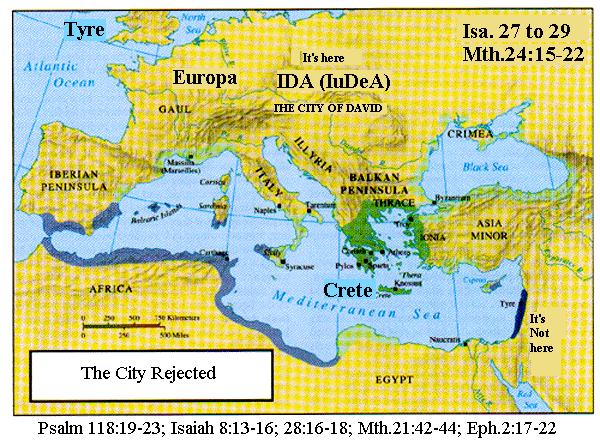
Statement by Dr.Thomas Klestil, Federal President of the Republic of Austria, on the occasion of unveiling the Memorial on Vienna's Judenplatz Square on Wednesday, 25 October 2000:
Distinguished Guests, Ladies and Gentlemen,
WHAT IS THE TIME SPAN OF OUR RECOLLECTIONS? WHAT PERIODS OF THE PAST CAN WE STILL REACH WITH OUR KNOWLEDGE, OUR THOUGHTS AND OUR FEELINGS?
DO THE NARRATIONS AND JUDGMENTS OF OUR ANCESTORS STILL REACH US? CAN WE STILL READ FROM THE STONES OF EARLIER TIMES? And another question: how long do times past last?
We have gathered here in a place where we face the checkered history of our country in a very special way, and which relates to us stories of suffering and joy, of supreme cultural achievements and unfathomable hatred. Here, on Vienna's Judenplatz Square, IT ALSO BECOMES VISIBLE THAT THE PAST AND THE PRESENT ARE CLOSELY LINKED TO ONE ANOTHER; here we come to realize that it is only on the basis of the past, which we cannot change anymore, that we can create a better future. THIS IS WHAT HISTORY TEACHES US.
We, Austrians, like to of think of ourselves as the successors and bearers of a great cultural tradition that - to this very day - enables us to achieve great accomplishments in this field. But if something applies to the bright side in our country, SHOULDN'T IT ALSO APPLY TO THE DARK SIDE AS IT? Shouldn't we, as heirs and successors, also face up to the tremendous barbarity of our history?
Let me briefly illustrate this ambivalence in our history:
Here, on Vienna's Judenplatz Square, stands the house where Wolfgang Amadeus Mozart wrote his opera "Cosi fan tutte", with Lorenzo da Ponte, his librettist, who was the son of a Jewish craftsman from Venetia, coming to see him frequently in house number four.
Here, on Vienna's Judenplatz Square, many Jews gathered for their common prayers, as early as the late Middle Ages. However, we also find here evidence for many centuries of hatred against the local Jewish population. We are standing now on the foundations of that synagogue where, more than 500 years ago, the repeatedly flaring phases of expulsion, persecution and killings of Jews in Vienna culminated in their desperate act of self-conflagration. And we come to realize that - here again - THERE IS A LONG CHAIN OF INTERACTION AND INVOLVEMENT WHICH WE MUST ACCEPT, IN SORROW AND WITH HUMILITY, AS PART OF OUR HISTORY, AND WHICH RUNS THROUGH THE CENTURIES LIKE A STIGMA. (Like a Stigmata)? However, we must KNOW in order to be able to ACKNOWLEDGE.
Here, on Vienna's Judenplatz Square, you also see a statue of Gotthold Ephraim Lessing, the German poet, whose "Ring Parable" has remained alive to this day, as a forceful symbol for tolerance. For us, a plea attaches to his person, namely that - time and again - we must find the strength to actively and courageously stand up for tolerance and to accept those who are different and are strangers.
Here, on Judenplatz Square, finally, we will unveil a memorial today, which is dedicated TO THOSE AUSTRIAN JEWS WHO BECAME THE VICTIMS OF THE GREATEST INHUMANITY OF THE PAST CENTURY. If I use the expression inhumanity this is, in fact, not correct. After all, human beings devised, planned and consistently implemented this virtually industrial extermination of millions of their fellow men and women. There were many Austrians among those who let the flame of hatred burn so high in their hearts as only human beings are capable of admitting. And they were human beings – acquaintances, colleagues, neighbours, or even friends who were prepared, or had been moved, for the most diverse motives, TO TAKE PART IN THE GREATEST CRIME THAT HAS EVER BEEN COMMITTED AGAINST THE JEWISH PEOPLE: THE SHOA.
And the Lord said unto him, Go through the midst of the City, through the midst of Jerusalem, and set a mark upon the foreheads of the men that sigh and cry for all the abominations that be done in the midst thereof.
And to others he said in mine hearing, Go ye after him through the city, and smite: let not your eye spare, neither have ye pity:
Slay utterly old and young, both maids, and little children, and women, but come not near any upon whom is the mark; AND BEGIN AT MY SANCTUARY. Then they began at the ancient men which were before the house...(Ezekiel 9:4-7).
If we have come here today to unveil the memorial that Rachel Whiteread, the British artist, has designed and which seems fit - like no other monument - to describe that which cannot be described, then we must also admit that many Austrians share in the blame of having committed the crimes of the Nazi regime. And we must also insist and demand anew THAT WE MUST REJECT AND FIGHT AGAINST ANY FIRST SIGN OF ANTI-SEMITISM AND RACISM IN AUSTRIA TODAY. There is no way around it, nor any looking to the side. There must be no compromise, nor concession.
The same holds true when addressing the question of returning expropriated belongings to deportees or their descendants, or of finding the best possible way to compensate them for the injustices that they have suffered. Austria adopted restitution laws which stipulate that the Government must take the iniative and examine ownership relations. Austria's federal museums and art galleries have already returned to their lawful owners a great many works of art which were unjustly in their possession. As you may know, several bilateral agreements were signed yesterday in connection with the issue of slave and forced labour. And we are also making efforts to find a solution, acceptable to both sides, regarding "aryanizations". The negotiations relating to this issue began yesterday.
THIS GRADUAL COMING TO TERMS WITH THE PAST– also in a legal sense – was neglected for a long time – for too long, in fact. As a result, there has been a strain on this so very important relationship with our fellow Jewish citizens and their descendants. It must therefore be in our all interest to make up for these omissions. We also want the Jewish community in Austria to know that their contribution to the cultural life of this country is a very valuable, even inalienable component of how we see ourselves in this country. Austria and, in fact, Europe owes many different and impressive elements to Judaism. We must therefore continue to promote and protect Jewish life.
Ladies and Gentlemen, Perhaps you may say: Haven't we known that all for a long time? Aren't these matters obvious? – Let me reply by also asking a question: Doesn't it also happen in Europe today that fire bombs are thrown at synagogues? Doesn't it happen time and again that Jewish cemeteries are desecrated? To be on the alert and to show personal courage are therefore the dictates of the hour. Together, let us be vigilant guardians of these virtues!
Of course, we can hear time and again questions like "Shouldn't we make a clean break with the events of the past? Shouldn't we stop looking back on the past all the time? Let me react by saying very clearly: It is only by remembering the victims that we are able to mould our future. That is the lesson that Simon Wiesenthal, the initiator of this Memorial, has taught us and followed as a model throughout his life. I would therefore like to thank Simon Wiesenthal most cordially - he who has been a great teacher for Austria when the issue at stake was to let the truth prevail. He has always regarded himself as a self-sacrificing admonisher. He has often been misunderstood; YET, HE NEVER GAVE UP FEELING COMMITTED SOLELY TO THE HISTORIC TRUTH. Hardly any other person but him knows so well how difficult it is to make it possible for others to experience our memories and to measure, in all their dimensions and complexity, the questions that I asked at the beginning: What is the time span for our recollections? How long do times past last? Richard Beer-Hoffmann, the Jewish poet, gave his answer to the questions in his very forceful verses when he wrote:
"All are within us. Who feels alone? You are their life – their life is yours."